Recent Trends in Commercial Health Insurance Market Concentration
Commercial health insurance markets remain highly concentrated across coverage types. However, the individual market, which consists mostly of the ACA Marketplaces, has attracted more insurers and witnessed greater insurer competition across a variety of measures since the implementation of the enhanced premium tax credits in 2021, according to a new Healthy System Tracker analysis.
